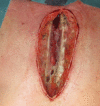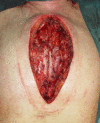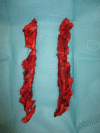The role of negative pressure wound therapy with instillation and dwell time in the treatment of deep sternal wound infections-A retrospective cohort study
- PMID: 37465238
- PMCID: PMC10350553
- DOI: 10.1002/hsr2.1430
The role of negative pressure wound therapy with instillation and dwell time in the treatment of deep sternal wound infections-A retrospective cohort study
Abstract
Background and aims: Negative pressure wound therapy (NPWT) has gained a central role in the treatment of deep sternal wound infections (DSWIs) after median thoracotomy. Our study aims at proving the safety of using NPWT with instillation and dwell time (NPWTi-d) in the treatment of DSWI.
Methods: We retrospectively evaluated the patients who were treated at our institution between March 2018 and November 2021 for DSWI after radical sternectomy using NPWT or NPWTi-d. The NPWTi-d was applied to start the first postoperative day using 75 mmHg negative pressure for 3 h, followed by instillation of sodium hypochlorite <0.08% with a 3-min dwell time.
Results: The NPWTi-d group showed a shorter length of stay (29.39 ± 12.09 vs. 39.54 ± 17.07 days; p = 0.049), a shorter elapsed time between the debridement and the flap coverage (7.18 ± 4.27 vs. 11.86 ± 7.7 days; p = 0.003) and less operative or nonoperative dressing changes (1.73 ± 1.14 vs. 2.68 ± 56; p < 0.001). The in-hospital mortality was 8.2%, with no significant differences between the two groups (p = 1).
Conclusion: NPWTi-d can be safely employed in the treatment of DSWI. Further prospective randomized studies need to establish the role of NPWTi-d in the control of infection and biofilm as well as in wound healing.
Keywords: cardiac surgery; instillation; negative pressure wound therapy; surgical wound infection; wound healing.
© 2023 The Authors. Health Science Reports published by Wiley Periodicals LLC.
Conflict of interest statement
The authors declare no conflict of interest.
Figures







Similar articles
-
Negative pressure wound therapy with instillation and dwell time in the wound management of necrotizing fasciitis.J Tissue Viability. 2021 May;30(2):262-266. doi: 10.1016/j.jtv.2021.02.012. Epub 2021 Mar 4. J Tissue Viability. 2021. PMID: 33707160
-
Treating Fasciotomy Wounds with Negative Pressure Wound Therapy with Instillation and Dwell Time (NPWTi-d).Cureus. 2016 Oct 28;8(10):e852. doi: 10.7759/cureus.852. Cureus. 2016. PMID: 27909640 Free PMC article.
-
Use of negative pressure wound therapy with automated, volumetric instillation for the treatment of extremity and trunk wounds: clinical outcomes and potential cost-effectiveness.Eplasty. 2014 Nov 3;14:e41. eCollection 2014. Eplasty. 2014. PMID: 25525480 Free PMC article.
-
Clinical recommendations and practical guide for negative pressure wound therapy with instillation.Int Wound J. 2016 Apr;13(2):159-74. doi: 10.1111/iwj.12452. Epub 2015 May 23. Int Wound J. 2016. PMID: 26011379 Free PMC article. Review.
-
Evolving Role of Negative Pressure Wound Therapy with Instillation and Dwell Time (NPWTi-d-) in Management of Trauma and Orthopaedic Wounds: Mechanism, Applications and Future Perspectives.Indian J Orthop. 2023 Nov 1;57(12):1968-1983. doi: 10.1007/s43465-023-01018-x. eCollection 2023 Dec. Indian J Orthop. 2023. PMID: 38009182 Free PMC article. Review.
Cited by
-
A Comparative Analysis of Negative Pressure Wound Therapy Methods for Sternal Wound Infections.Plast Reconstr Surg Glob Open. 2025 Mar 7;13(3):e6579. doi: 10.1097/GOX.0000000000006579. eCollection 2025 Mar. Plast Reconstr Surg Glob Open. 2025. PMID: 40061171 Free PMC article.
References
LinkOut - more resources
Full Text Sources

